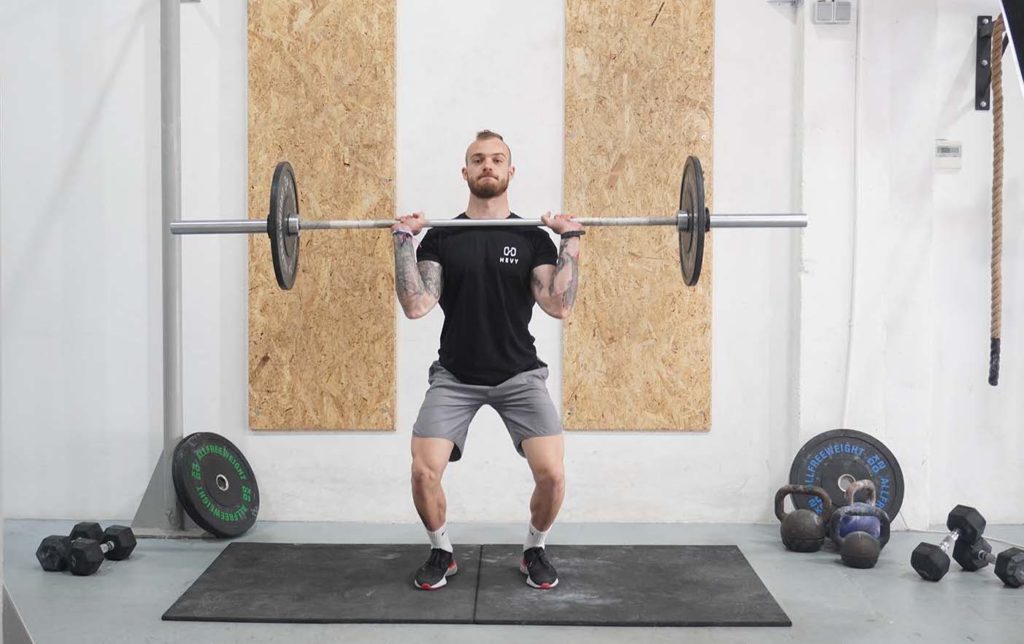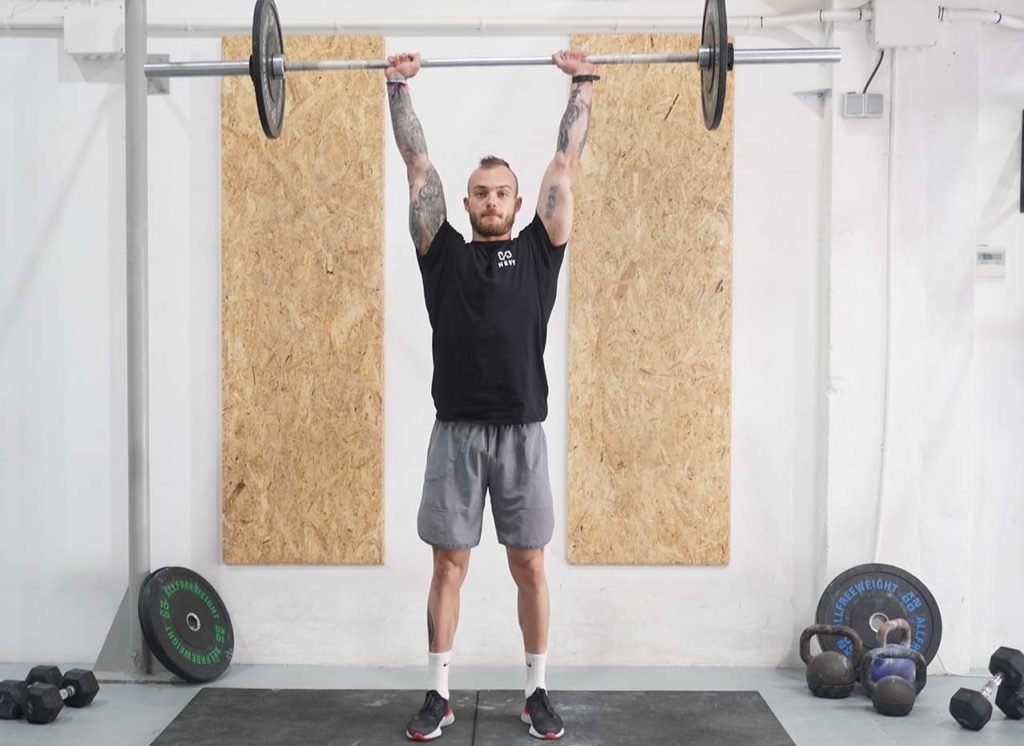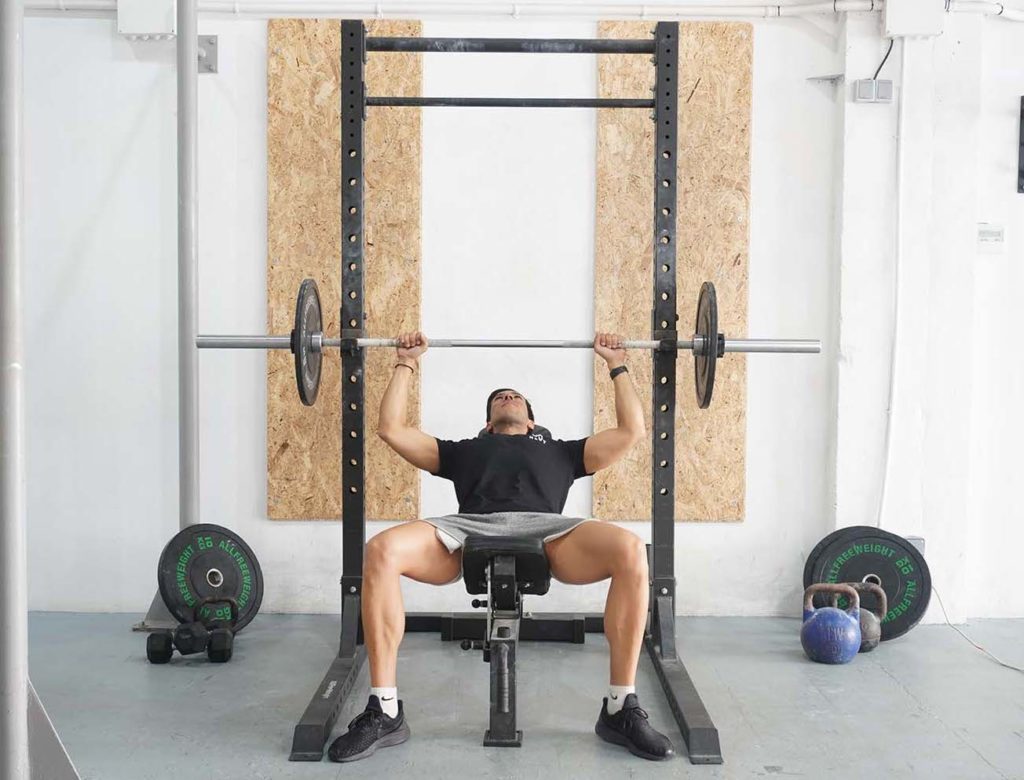Benefits of the Push Press
The push press is a whole-body dynamic exercise that builds strength, power, and muscle mass. Like the military press, the idea of the movement is to lift a barbell above your head. But, instead of doing strict repetitions, you generate some momentum through your lower body. As a result, the push press allows you to use more weight, develop power, and overcome strength plateaus.
Adding the push press to your training is beneficial because the exercise forces your body to work as a single unit. You have to generate force from the ground up and transfer it into the barbell. The movement develops athleticism, strengthens your core, and makes everyday tasks more accessible (1).
We recommend performing the push press early in a workout. As a compound movement, you should approach the push press in a fresh state, allowing you to use good technique and generate more power.
How to do a Push Press

- Place the barbell in a front rack position: your hands outside shoulder-width level with a full grip on the bar as it sits atop your shoulders.
- Your elbows should be positioned in front of the bar, and you should keep it pressed against your body to prevent forward rolling.
- Position your feet at roughly hip-width level with toes pointed slightly out.
- Take a deep breath and initiate the dip phase by bending your knees and hips while keeping your torso upright. The descend doesn’t have to be quick; instead, aim to make it a smooth motion.
- As you dip a few inches, change the direction by pushing through your heels to extend your knees and hips.
- As your hips and knees extend, use your lower body’s momentum to push through your torso and lift the bar off your shoulders.
- From there, immediately push through your elbows to extend the bar above your head. These two steps should happen in one smooth and seamless motion.
- Assume a strong lockout position by extending your elbows fully, keeping your torso upright, and having your hips and knees extended.
- Exhale and slowly lower the barbell to the initial position, resting atop your shoulders.
- Take another breath and repeat.
What muscles does the push press activate?
The push press trains a range of muscles. Most notably, the activity works your pushing muscles: the shoulders (deltoids), triceps, and upper chest (1). Our shoulders serve as the primary movers, and our triceps and upper chest assist with pressing the barbell up.
Our midsection musculature also plays a vital role in the push press. The obliques, rectus abdominis, transverse abdominis, erector spinae, and several other muscles flex isometrically to maintain a stable torso.
The latissimus dorsi, rhomboids, infraspinatus, rear deltoids, and trapezius (collectively making up the upper back) also work during push presses. Similar to our midsection, these muscles contract isometrically, allowing us to keep our shoulders back and torso stable.
Unlike a strict overhead press, push presses also train the lower body. Specifically, we have to bend our knees slightly, creating momentum off the bottom. The motion trains our quadriceps to a degree.
Proper Form and Technique when Performing a Push Press
A vital tip to keep in mind for a proper push press is to maintain the barbell over your center of gravity. Meaning, the weight should be over mid-foot during each repetition. The position would allow for maximum power output and good stability. In contrast, having the weight travel behind or in front of your body can knock you off balance, forcing you to miss a repetition or drop the weight.
Dipping is also vital for creating momentum off the bottom and transferring force into the barbell. Specifically, you should plant your feet into the floor and descend into a quarter squat before driving in a straight vertical line.

Timing the barbell press is also essential and takes some practice. You must use the momentum you create with your lower body to thrust the weight up. The barbell should fly off your shoulders just as your ankles, knees, and hips extend. An efficient execution will allow for maximum power transfer and better performance.
Variations and Modifications of the Push Press
1. Kettlebell Push Press
The kettlebell push press is a variation you would typically do with one arm at a time. The goal is to grab a kettlebell and have it in a front rack position with your elbow close to your body. Once in place, dip, explode up and send the kettlebell flying straight up.
2. Pause Push Press
Pause push presses are a beneficial exercise that reinforces proper technique and reduces the risk of balance loss. The idea with pause push presses is to descend into a quarter squat and hold the position for a second or two before driving up and pressing the weight.
3. Dumbbell Push Press
Dumbbell push presses are a beginner-friendly variation that allows you to practice the exercise, even if you don’t have a barbell around. Grab a pair of dumbbells, lift them to your sides, dip into a quarter squat, and drive up. Aside from being less intimidating, the variation forces both sides of your body to work independently, reducing the risk of side-to-side imbalances.
Mistakes to Avoid
A common mistake with the push press is trying to lift too much weight. Trainees hear that push presses allow for more significant loading, so they add a bunch of weight to the barbell. The problem is, doing so prevents the use of proper technique and increases the risk of injuries. You should start with conservative loads that allow you to do at least 8 to 10 good repetitions.
Another mistake relates to dipping. Some trainees dip by shifting their hips back, which creates a less stable surface for the barbell, increasing the risk of dropping it forward. Fix the mistake by only bending at the knee and maintaining an upright torso as you dip.
The third mistake with push presses relates to grip width. Many trainees struggle to find the correct grip and often have their hands too close together or wider than they need to. The ideal grip width for the push press is at shoulder level. Stand in front of the rack, raise both arms forward, and place them on the barbell. In most cases, that would be your ideal grip width.
Similar Exercises to the Push Press
Standing Military Press (Barbell)
The standing military press is similar to push presses in many ways. You have to support yourself on your feet, lift a barbell overhead, use a similar range of motion, and train many of the same muscles (2). The only difference is that you would do strict repetitions on the military press but create momentum off the bottom during push presses.
Incline Bench Press (Barbell)

The incline barbell bench press is a compound exercise that strengthens the shoulders, triceps, and upper chest (3). Like the push press, incline pressing trains many of the same muscles through a similar range of motion and offers an impressive overloading potential.

